Magnetic properties and magnetocaloric effect in RE55Co30Al10Si5(RE=Er and Tm)amorphous ribbons
Hao Sun(孙浩) Junfeng Wang(王俊峰) Lu Tian(田路) Jianjian Gong(巩建建)Zhaojun Mo(莫兆军) Jun Shen(沈俊) and Baogen Shen(沈保根)
1School of Rare Earths,University of Science and Technology of China,Hefei 230026,China
2Ganjiang Innovation Academy,Chinese Academy of Sciences,Ganzhou 341000,China
3Key Laboratory of Cryogenics,Technical Institute of Physics and Chemistry,Chinese Academy of Sciences,Beijing 100190,China
The magnetic and magnetocaloric effects (MCE) of the amorphous RE55Co30Al10Si5 (RE =Er and Tm) ribbons were systematically investigated in this paper. Compounds with R=Er and Tm undergo a second-order magnetic phase transition from ferromagnetic (FM) to paramagnetic (PM) around Curie temperature TC ~9.3 K and 3 K, respectively.For Er55Co30Al10Si5 compound,an obvious magnetic hysteresis and thermal hysteresis were observed at low field below 6 K, possibly due to spin-glass behavior. Under the field change of 0 T–5 T, the maximum values of magnetic entropy change (-x) reach as high as 15.6 J/kg·K and 15.7 J/kg·K for Er55Co30Al10Si5 and Tm55Co30Al10Si5 compounds,corresponding refrigerant capacity(RC)values are estimated as 303 J/kg and 189 J/kg,respectively. The large MCE makes amorphous RE55Co30Al10Si5 (RE =Er and Tm) alloys become very attractive magnetic refrigeration materials in the low-temperature region.
Keywords: magnetocaloric effect,amorphous,magnetic refrigeration,magnetic property
1. Introduction


successfully prepared,and their magnetic properties and MCE were systematically studied
2. Experimental details
Firstly,pre-alloyed ingots with a nominal composition ofRE55Co30Al10Si5(RE=Tm and Er) were fabricated by arcmelting the mixtures of pure metals in stoichiometric ratio under argon atmosphere. The purity of rare elements Er and Tm exceed 99.9%, and the purity of other ingredients is not less than 99.99%. Besides, an additional 5%REcomponents were added to compensate for evaporation losses. During the arcmelting process, the ingots were turned over and remelted four times to guarantee the homogeneity of the composition.Then, the molten pre-alloyed ingots heated by an induction coil were pressure sprayed with argon gas onto a single copper wheel with a linear surface velocity of 35 m/s. Finally,the structure and magnetic properties of the amorphous ribbons were measured. The structure of samples was ascertained by the x-ray diffraction (XRD) model Bruker D8A A25 in the range of the Bragg angles(2θ)from 25°to 85°using the Cu-Kαradiation. The magnetic measurements were conducted using a commercial vibrating sample magnetometer (VSM),model PPMS-9(Quantum Design).
3. Results and discussion
Room temperature XRD patterns ofRE55Co30Al10Si5(RE=Tm and Er)ribbons are illustrated in Fig.1. Both compounds possess vast diffraction peaks and no sharp crystalline peaks,which is typical amorphous characteristics.

Fig. 1. Room temperature XRD patterns for RE55Co30Al10Si5 (RE =Tm and Er).
Figures 2(a)and 2(b)show the temperatureTdependence of magnetizationM(left-hand scale) measured by zero-fieldcooled (ZFC) and field-cooled (FC) mode and the reciprocal susceptibility 1/χ(right-hand scale)forRE55Co30Al10Si5(RE=Er and Tm) underμ0H=0.01 T, respectively. It is observed there is a distinct discrepancy between the ZFC and FC branches of Er55Co30Al10Si5at low temperature.The thermomagnetic irreversibility usually occurs in some amorphous materials with spin-glass systems.[13]In contrast,the ZFC and FC curves of Tm55Co30Al10Si5are almost overlapping over the whole temperature ranges.The Curie–Weiss fit to the 1/χ–Tcurves of both compounds suggests that the values of 1/χat high temperature obey the Curie–Weiss law

HereCis the Curie–Weiss constant,θPis the paramagnetic Curie temperature. Based on the result of Curie–Weiss fit, the values ofθPdeduced are 7.08 K and 0.17 K for Er55Co30Al10Si5and Tm55Co30Al10Si5, respectively. The positiveθPvalue indicates that the ferromagnetic(FM)interactions are dominant in these compounds. The Curie temperatures (TC) of compounds withRE=Er and Tm are determined to be 9.3 K and 3 K, respectively, corresponding to the minimum of(dMFC/dT)–Tcurves as shown in Figs.2(c)and 2(d). Notably, theθPvalues for both compounds are significantly lower than their respectiveTCvalues. The phenomenon is also observed in some Er-based and Tm-based ferromagnetic amorphous materials such as Er60Co20Ni20,[26]RE60Co20Al20(RE=Er and Tm),[30]RE55Ni18Al27(RE=Er and Tm).[31]For these materials, their magnetic moments all derived fromREatoms, indicating that all magnetic interactions are related toREatoms. Therefore, the characteristic may be associated with the crystalline electric field effects(CEF)due to the non-spherical symmetry of 4f electronic cloud for Er and Tm. Besides, it is clear seen from Fig. 2(c)that the thermomagnetic irreversibility between ZFC and FC occurs below 8 K and gradually increases with decreasing temperature.
The isothermal magnetization (M–μ0H) curves in the vicinity ofTCforRE55Co30Al10Si5(RE= Er and Tm) are given in Figs. 3(a) and 3(b). The magnetization of both alloys abruptly increases to tend saturation with the increasing field belowTC,reflecting a typical ferromagnetic feature. Figure 3(c) presents theM–μ0Hcurves in the mode of increasing and decreasing field from 0 T–0.5 T forRE55Co30Al10Si5(RE=Er and Tm). Apparently,the Er55Co30Al10Si5exhibits a large hysteresis at 2 K,which decreases with increasing temperature and almost disappears at 6 K. Nevertheless, no hysteresis is observed in Tm55Co30Al10Si5at 2 K. Considering the thermomagnetic irreversibility of Er55Co30Al10Si5also decreases with rising temperature and disappears completely at 8 K underμ0H=0.01 T. Therefore, it can be inferred that the hysteresis and thermomagnetic irreversibility may both originate from spin-glasses behavior. TheM–μ0Hcurves of Er55Co30Al10Si5in the mode of increasing field at various temperatures are demonstrated in Fig. 3(d). There are multiple crossover points forM–μ0Hcurves of Er55Co30Al10Si5at various temperatures,which may lead to a positive magnetic entropy change at low temperature and low field.

Fig.2. The M–T curves(left-hand scale)in the mode of ZFC and FC and(1/χ)–T curves(right-hand scale)of(a)Er55Co30Al10Si5 and(b)Tm55Co30Al10Si5 under μ0H =0.01 T.The M–T curves(left-hand scale)and(dM/dT)–T curves(right-hand scale)of(c)Er55Co30Al10Si5 and(d)Tm55Co30Al10Si5 in the temperature range from 0 K–30 K at μ0H=0.01 T.
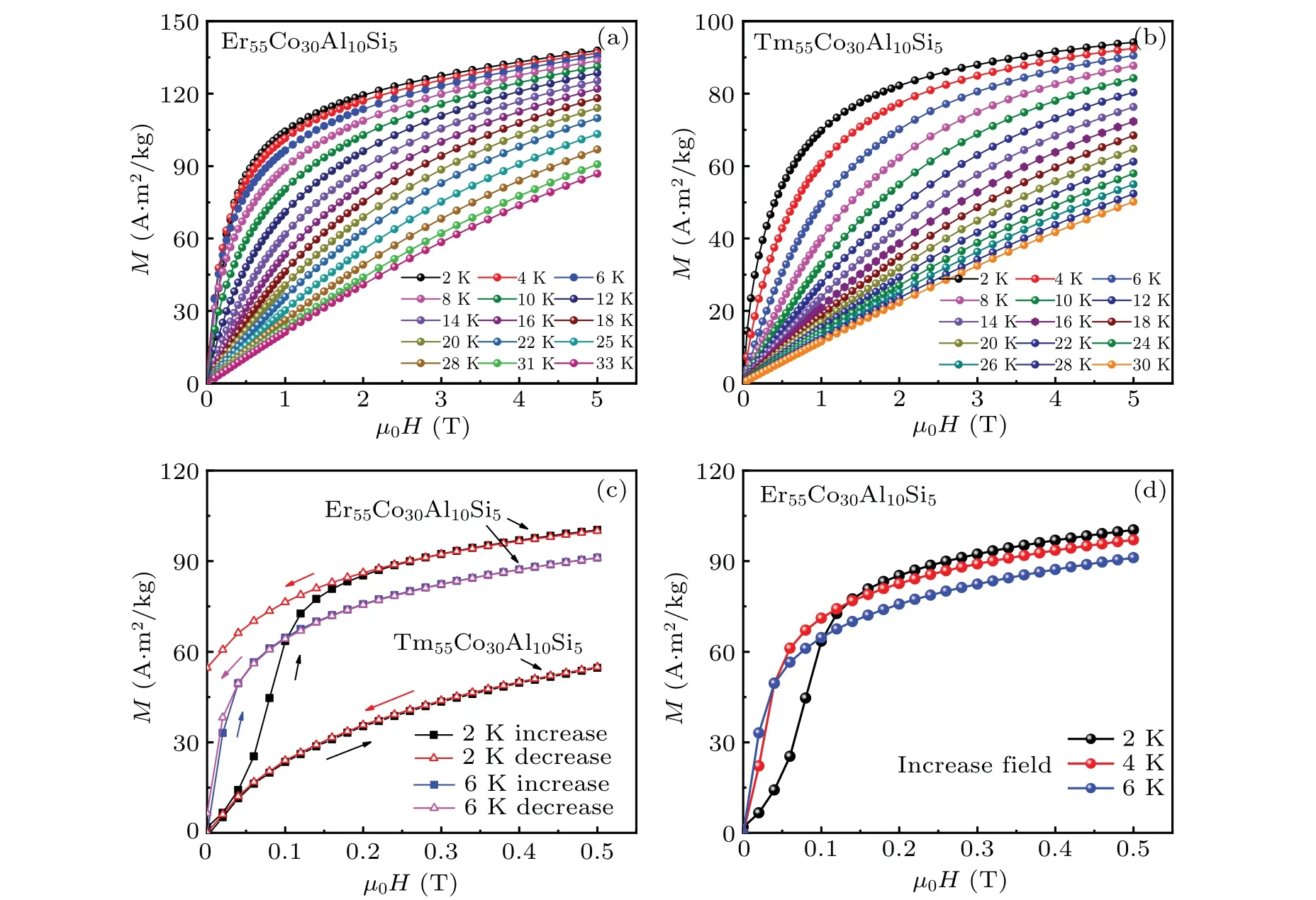
Fig. 3. The M–μ0H curves for (a) Er55Co30Al10Si5 and (b) Tm55Co30Al10Si5 at various temperatures under Δμ0H of 0 T–5 T. (c) The M–μ0H curves of Er55Co30Al10Si5 at 2 K and 6 K and Tm55Co30Al10Si5 at 2 K in the mode of increasing and decreasing magnetic fields from 0 T–0.5 T.(d)The M–μ0H curves of Er55Co30Al10Si5 at 2 K,4 K,and 6 K measured by increasing field from 0 T–0.5 T.

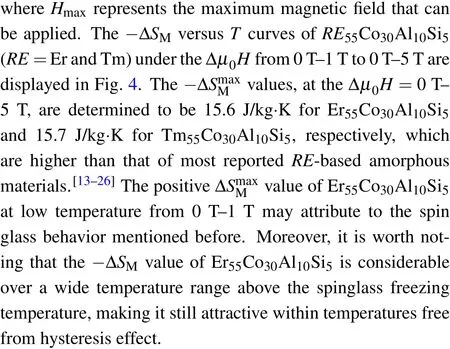
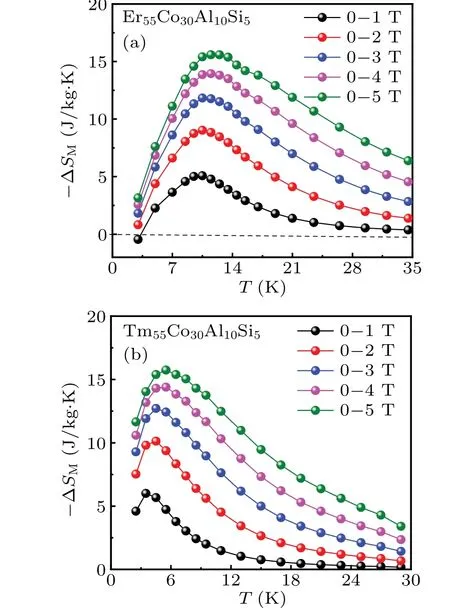
Fig.4. The-ΔSM versus T curves of RE55Co30Al10Si5 (RE =Er and Tm)under the Δμ0H for different magnetic field changes up to 5 T.



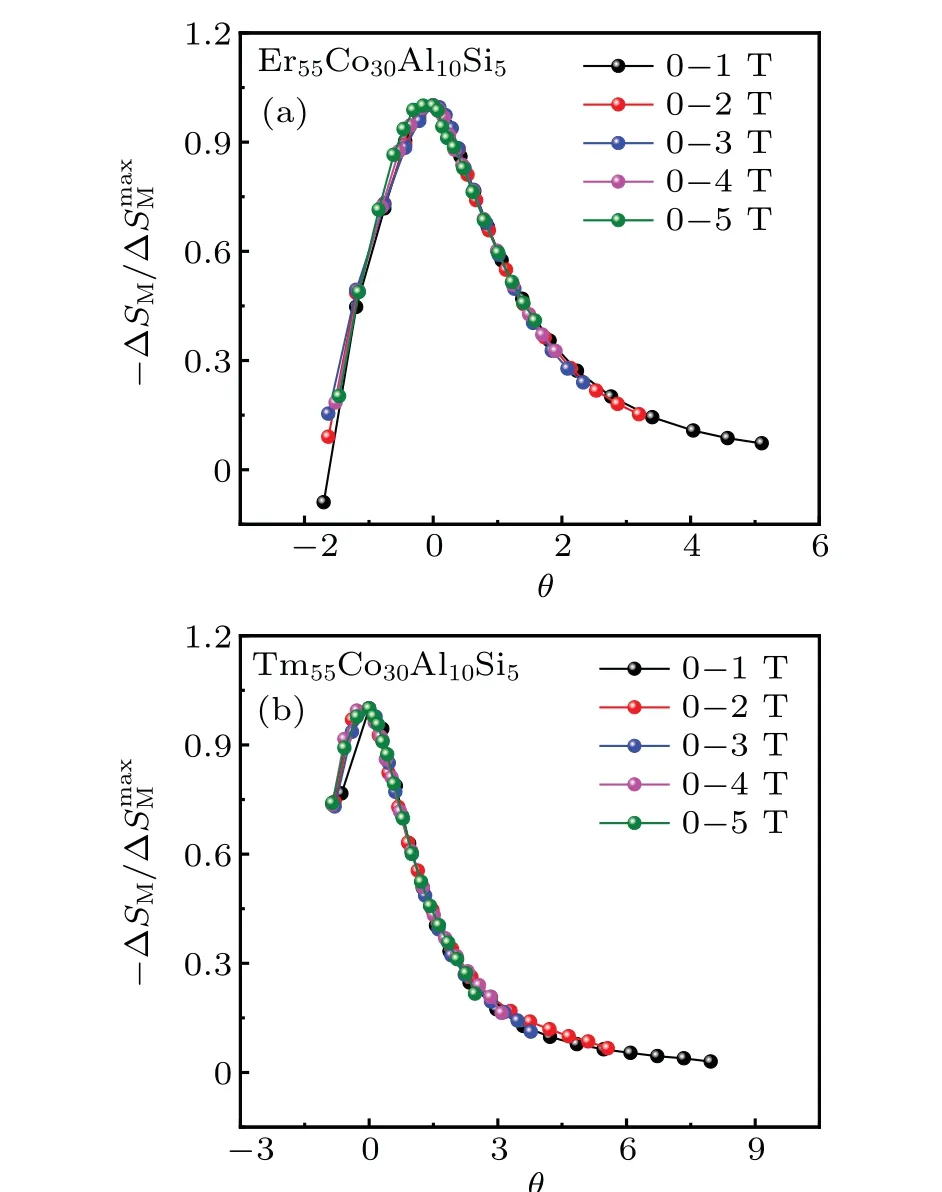
Fig. 5. Normalized magnetic entropy change as a function of the rescaled temperature for(a)Er55Co30Al10Si5 and(b)Tm55Co30Al10Si5 with Δμ0H from 0 T–1 T to 0 T–5 T.


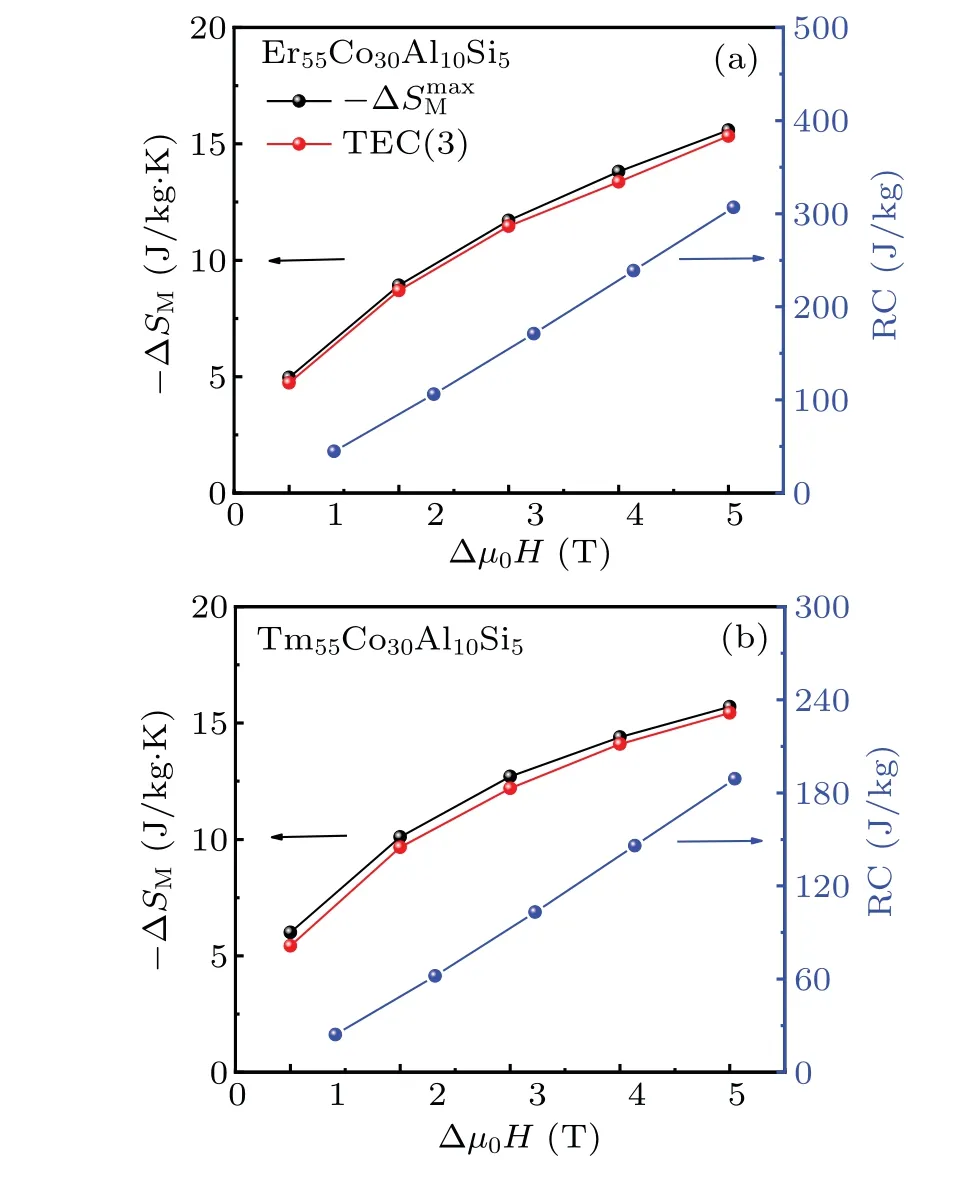
Fig.6. TEC(3)and- (left axis),and RC(right axis)as a function ofΔμ0H for RE55Co30Al10Si5 (RE=Er and Tm).
Table 1. The TC,||,and RC parameters for RE55Co30Al10Si5 (RE =Er and Tm)and some reported promising MCE materials at low temperature under Δμ0H=0 T–5 T.

Table 1. The TC,||,and RC parameters for RE55Co30Al10Si5 (RE =Er and Tm)and some reported promising MCE materials at low temperature under Δμ0H=0 T–5 T.
Materials TC ΔSmaxM (J/kg·K) RC(J/kg) Refs.Tm55Co30Al10Si5 3 15.6 189 present Er55Co30Al10Si5 9.3 15.7 303 present Tm60Al20Ni20 4.4 14.1 ~180 [34]Er60Al20Ni20 9.5 14.3 ~280 [34]Tm60Co20Al20 5 15.06 243.4 [30]Er60Co20Al20 10.3 15.57 391.8 [30]Tm60Ni30Co10 6.3 14.2 ~165 [35]Er60Ni30Co10 11.5 12.1 ~230 [23]


4. Conclusion

Acknowledgements
Project supported by the National Natural Science Foundation of China (Grant Nos. 52171195 and 52171054), the National Natural Science Foundation for Distinguished Young Scholars (Grant No. 51925605), and the Scientific Instrument Developing Project of the Chinese Academy of Sciences(Grant No.YJKYYQ20200042).
- Chinese Physics B的其它文章
- A design of resonant cavity with an improved coupling-adjusting mechanism for the W-band EPR spectrometer
- Photoreflectance system based on vacuum ultraviolet laser at 177.3 nm
- Topological photonic states in gyromagnetic photonic crystals:Physics,properties,and applications
- Structure of continuous matrix product operator for transverse field Ising model: An analytic and numerical study
- Riemann–Hilbert approach and N double-pole solutions for a nonlinear Schr¨odinger-type equation
- Diffusion dynamics in branched spherical structure

